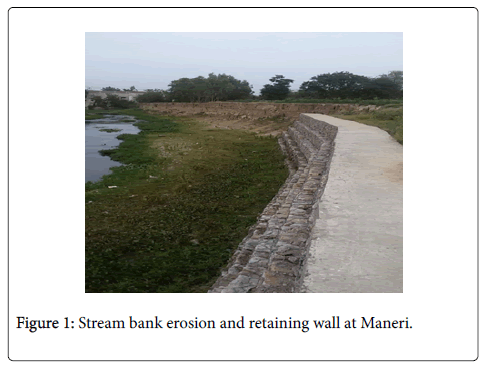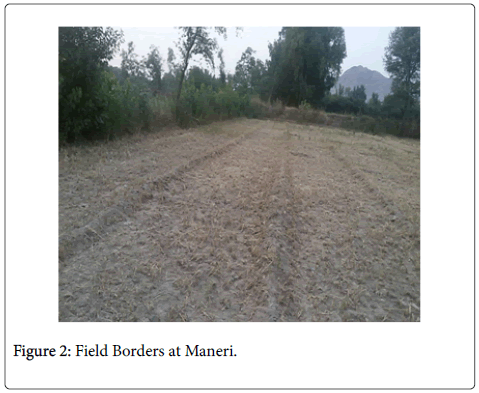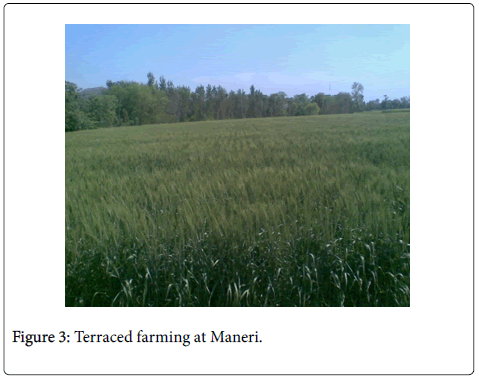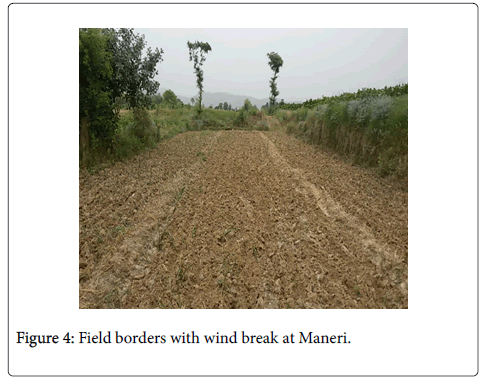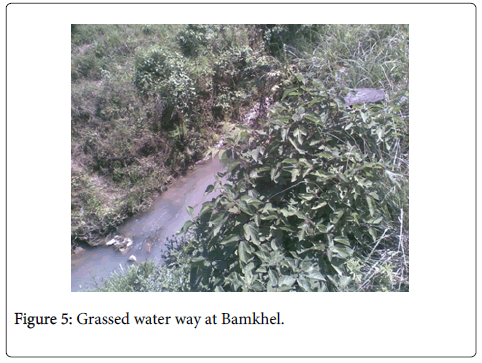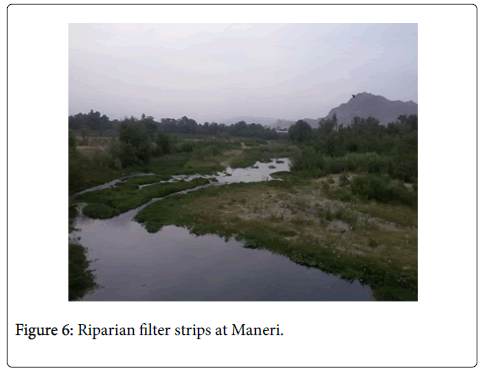Soil and Water Conservation Practices in District Swabi, KP, Pakistan
Received: 10-Apr-2018 / Accepted Date: 09-May-2018 / Published Date: 19-May-2018 DOI: 10.4172/2329-8863.1000366
Abstract
This study is based on survey of the conservation practices adopted by the farmers in various regions of District Swabi (34°10'23" N, 72°34'80" E), (Pakistan). The surveyed area comprised of 86 zones of the District to assemble farmer’s practices for conservation of water and soil. A few reviews demonstrated that over 70% of the world rural areas face direct decline. Water is likewise turning into a rare resource by sedimentation, contaminating with various chemicals. The adoption of a particular conservation practice in any zone seems to have relation with the region’s climatic conditions and land relief. For instance, the practices in Baja (with a relatively smaller slope gradient) were different to that adopted in Utla (with higher slope gradient) where stone walled terracing was the most common practice. Additionally, use of conservation practices were also dependent upon the extent of precipitation and wind, and the regions where precipitation was high, conservation practices were for the most part stubble mulching, cover crops, grass strips, field borders and filter strips that can diminish overflow by improving infiltration. Whilst the areas with higher level of wind erosion were, generally, proliferated with wind breaks and trees plantations. From the results it is obvious that farmers adoptive conservation practices in District Swabi were more focused on decreasing the soil loss, ensuring a safe habitat for natural biodiversity, improving soil fertility and increasing bioenergy production which should help increase financial gains of the farming community living in the area.
Keywords: Agricultural field; Conservation practices; District Swabi; Soil erosion; Water erosion
Introduction
Fast soil erosion is related essentially with falls and primitive cultivation practices that degrade the soil physically, chemically and biologically. The problem is worth for special attention in the sloping areas of the nation especially in ranges with high yearly precipitation where a significant part of the rain misses the marked timeframes (Ellies). Low efficiency is the basic element of rain-fed agriculture as a result of soil disintegration, unpredictable and insufficient precipitation, low natural matter substance, poor physical condition, hardpan and other undesirable ecological conditions like dry air and high soil temperatures. Because of these reasons, the effect of rain-fed regions on national economy is negligible. Therefore, extraordinary potentials are needed to launch suitable and coordinated soil and water conservation practices to improve crop productivity in such areas.
In 1987, the International Joint Commission (IJC), an association that had individuals from Canada and the United States, recorded Severn Sound and different zones along the Great Lakes with corrupted water quality as Areas of Concern (AOC). The activities to re-establish a solid domain for the group included the advancement of a Remedial Action Plan (RAP) administered by the Severn Sound Environmental Association (SSEA 1993). The RAP provided the chance to update the sewage treatment plants and actualize broad protection projects to enhance the water quality inside the locale. The most generally used best management practices (BMPs) included stream bank fencing; expanded woodland cover; riparian cradles; redesigned compost storerooms; drain house wash water treatment and wind breaks/shelter belts and cropland assurance practices (CAPs) for example: edit turn, cover crops, preservation culturing and no culturing (SSEA 2002). In 2003, after the SSEA achieved its objective of enhancing the water quality and re-establishing untamed life living space in Severn Sound, the IJC delisted the Severn Sound watershed as an AOC.
While watershed directors have different administration alternatives, the adequacy of every choice in alleviating the negative effects on water quality and amount should be evaluated before practices are executed. For higher achievement rate, data is likewise required on where to ideally intercede to best devoted endeavors and assets. Usage of BMPs can diminish soil disintegration and enhance water quality by lessening silt and chemicals deposition that are washed by spill over from developed fields. Since their adequacy can't be assessed in all circumstances, watershed chiefs depend on models to give a gauge of the effect of specific BMPs on water quality at watershed scale. The Soil and Water Assessment Tool (SWAT) has been utilized to assess water quality advantages of farming protection rehearses [1]. It offers the best number of administration alternatives for demonstrating rural watersheds [2].
The reasons for land corruption can be gathered in three noteworthy classes:
• Climatic (e.g., precipitation, dry spell).
• Bio-geophysical (e.g., slant, soil sort).
• Managerial (e.g., rancher instruction, encounter, access to augmentation administrations).
These three gatherings of factors are basic in deciding the probability and speed of soil disintegration [3].
Soil erosion is devastating to agricultural soils, water resource projects and environment. In Pakistan, 76% of the land has experienced erosion; more than 36% relates to water and 40% to wind. In a review by Hantush and Kalin, water disintegration brought about 7 t ha-1 soil amid summer season [2]. Low and unpredictable rain and soil disintegration are the significant soil related issues of the rain nourished agribusiness grounds of Khyer Pakhtunkhwa (KP) Province. These terrains can be enhanced through coordinated planting management, and soil moisture preservation rehearses.
Materials and Methods
The information utilized as a part of this survey was produced from a farm level study of small scale agriculturists. Diverse protection strategies were adopted by various agriculturists of District Swabi. This section gives the practices for the protection of soils and water [4].
Location and description of the study area
District Swabi (34°10'23" N, 72°34'80" E) lies between the River Indus and River Kabul, in the KP (Khyber Pakhtunkhwa) Province of Pakistan. The estimated population of District Swabi is 1,826,804 (2005) having area estimated is 1,543 km2. Their main occupation is associated with agriculture which is 52.6% and is on the top among all. Swabi is home of dozens of streams and two great rivers, the Indus and Kabul. Both the rivers meet at a place called kund, a major tourist attraction. The Indus river with its spectacular blue color and the Kabul rivers muddy brown waters go side by side without blending. Also, there are several small streams in different locations of Swabi. A unique stream is in village Maini. Its water is used for irrigation in the village. This stream is called cheena in local language which means spring. The three villages namely Kotha, Topi and Maini are collectively Utman. They all have natural springs called cheena in Maini, cheeno in Kotha and bayin in Topi [5].
Tobacco is a money harvest of Swabi, alongside vegetables, wheat, sugarcane and maize. Its atmosphere is appropriate for citrus specifically, however numerous different natural products like watermelon, peaches and apricots are likewise developed there. Swabi SCARP (Salinity control and Reclaimation project) reclaimed salt affected and water-logged areas in Swabi, which indicated positive outcomes on product yield and nature of soil. A portion of the region is hilly and for the most part people groups utilize it for tourism like Mahaban Hill in Gadoon has an attractive sight like Swat and other sloping regions. Pir-Galai resort is here, 6000 feet over the sea level. From here one can see Mansehra, Buner and kaghan mountains [6].
Areas of study
As there are more than 150 small villages in Swabi, only the villages which mostly and highly depend on agriculture were selected. Areas from which the data was collected are given in Table 1 alphabetically.
| S No | Areas | S No | Areas |
|---|---|---|---|
| 1 | Adina | 44 | Lahore |
| 2 | Anbar | 45 | Malak Abad |
| 3 | Ismail Abad | 46 | Maneri |
| 4 | Asota Sharif | 47 | Manki |
| 5 | Baja | 48 | Mansabdar |
| 6 | Bamkhiel | 49 | Marghuz |
| 7 | Batakara | 50 | MathraDagai |
| 8 | Beka | 51 | Meni |
| 9 | Boka | 52 | MianDheri |
| 10 | Chanai | 53 | Musa Banda |
| 11 | Charbagh | 54 | Nabi |
| 12 | Dagi | 55 | Naiknam |
| 13 | Dandoqa | 56 | Naranji |
| 14 | Darra | 57 | Nawa kali |
| 15 | Dhok | 58 | Pabeni |
| 16 | Dobyan | 59 | Palo Dand |
| 17 | Dodher | 60 | Panjpir |
| 18 | GaarMunara | 61 | Parmoli |
| 19 | Gadoon | 62 | Salim Khan |
| 20 | Gala | 63 | Saproona |
| 21 | Gandaf | 64 | Sardcheena |
| 22 | GaniChatra | 65 | Serai |
| 23 | Ghazi kot | 66 | SeraiCharbagh |
| 24 | Gohati | 67 | Shahmansoor |
| 25 | GuluDheri | 68 | ShahdadKalli |
| 26 | Haryan | 69 | Shawa |
| 27 | Hund | 70 | Shiekh Jana |
| 28 | Ismaila | 71 | Sikandri |
| 29 | Jaganath | 72 | Sudher |
| 31 | Jalsai | 74 | Tano |
| 32 | Jamal Abad | 75 | Tarakai |
| 33 | Janda | 76 | Tarbela |
| 34 | Juma Khan Garhai | 77 | Thandkoi |
| 35 | Kadi | 78 | Topi |
| 36 | Kala | 79 | Tordher |
| 37 | Kalabat | 80 | Toolandai |
| 38 | KaluDher | 81 | Utla |
| 39 | Kalu Khan | 82 | Yaqubi |
| 40 | KarnalSherKilli | 83 | YarHussain |
| 41 | Kaya | 84 | Zaida |
| 42 | Kotha | 85 | Zakarya |
| 43 | Kunda | 86 | Zarobi |
Table 1: Areas of research.
Strategies applied
Particular use of soil and water administrations learning with the objective of shielding soil assets from abuse, pulverization or disregard is soil and water conservation practices. Shifting procedures are connected by the agriculturists in various regions which are described one by one. There are the techniques generally utilized by the farmers.
Brushwood check dams
It comprises of two columns of wooden poles that are immovably settled in the soil having a space of appropriate separation. The spaces between these two columns are loaded with heaps of little branches.
Contour cultivating
Cultivating perpendicular to the slope is known as contour cultivation. It is the cultivating with column designs that run water almost level around the slope not all over the slope.
Contour buffer strips
Contour buffer strips are the strips of both grasses and legumes that catches sediments and reduce soil erosion.
Contour hedgerow system
Using of single or double hedgerow of nitrogen fixing trees or shrubs planted very densely along contour line with crops growing in the alleys between hedgerows.
Crop rotation
“Changing of crops grown on a single field year by year”. Grasses and legumes protects water quality by removing sediments from water and reduces erosion.
Cropping system
Selection of proper cropping system is the key to success of conservation-oriented farming. Study of relay cropping and intercropping is helpful in the readjustment of the cropping systems if the results are encouraging. In the potohar areas the dofasli-dosala (two crops in two years) is the common system of cropping.
Diversion
Diversion is an earthen embankment that collects water that are not infiltrated from a specific area. It reduces soil erosion on low land by catching runoff water and preventing its reaching to farm land below.
Effective stubble mulching
It is the practice of spreading plants residues or any other material like straw or stone on the soil surface to reduce evaporation water losses. It has been found effective in conserving soil moisture, regulating soil temperature, preventing crust formation and protecting soil against erosion.
Fertilizer use
Soil fertility is a very important factor in the conservation of soil and water. Fertile soils produce high crop yields and also have better physical properties then infertile soils. Organic matter improves the structure of the soil so a fertile soil with adequate amounts of organic matter would be resistant to erosion.
Field borders
Growing of grasses and legumes at the edges of the field in places of the end rows. Field borders reduce sheet and rill erosion by slowing water flow. Growing grasses and legumes may also increase the fertility by trapping the sediments from runoff water which are the most fertile soil.
Field embankments
In this method the field boundaries are raised to a height of about 15-50 cm depending on the rainfall and slope of the land. In low rainfall areas the height should be about 50 cm to absorb more water into the soil.
Forest farming
Main component of soil organic matter is plant residue which mostly contains forest plants. As forest farming reduces soil loss by decreasing the velocity of rain drop, so runoff is minimized with forest farming. Another importance of forest farming is its organic matter which improves soil structures and reduces soil loss by water erosion.
Grassed water ways
A natural drainage way impounded with grasses to prevent erosion loss by safe flow of water from the field. It mostly protects the soils from gully formation, as the sediments are safely separated from the runoff water.
Maintaining crop cover
Maintaining crop cover can improve the inherent soil properties. Fallow soil should be ploughed across the slope before the onset of the rainy season and occasionally thereafter. Runoff is highest in fallow soils then soils having cover crop.
Pasture planting
Planting herbs and shrubs protects the area from both wind and water erosion. Heavy grass cover slows water flow and thus reducing soil erosion. It also protects water from sedimentation as they filter runoff water.
Riparian filter strips
Growing of water loving plants near the banks of streams, rivers and lakes. These strips reduce flooding and thus minimize erosion. It also provides shelter for wildlife.
Stone walled terraces
These are installed when the volume of water is very great. With this the sides of these terraces should be covered with grasses, shrubs and trees to stop further widening.
Terrace farming
The field terrace is an earthen embankment adjusted to soil and slope to control runoff. It is designed primarily for the control of runoff in high rainfall areas and for the conservation of water in low rainfall areas.
Tree planting
Tree planting is used to establish trees in areas adapted to wood land. Ground cover created by trees protects the soil from erosion in addition to profit.
Wind break system
These are vegetative barriers of sufficient height to create a windless zone for protected sites. These are rows of trees and shrubs that protect areas from wind and improve quality of water by controlling wind erosion and provide shelter for wild life.
Results
Soil and Water conservation practices are the particular utilization of water and soil administration learning with the objective of protecting soil assets from misuse, decimation or disregard. Soil conservation relies upon land utilize, soil qualities, topographic conditions, precipitation and disintegration hazards. Arrive administration refers to the correct utilization of land, and product administration refers to the choice of harvests, culturing practices, and social operations [7,8].
Diverse areas farmers connected differing protection measures in the field to minimize disintegration. The accompanying tables narrate about the site specific and diverse practices for moderating soils erosion (Table 2).
| S No | Areas | Practices applied |
|---|---|---|
| 1 | Adina | Field borders, Terrace farming, Crop cover, Fertilizers, Grassed water ways, Pastures and Wind breaks. |
| 2 | Anbar | Buffer strips, Terrace farming, Stubble mulching, Crop cover, Tree planting, Diversion, Field borders, Wind breaks and Grassed strips. |
| 3 | Ismail Abad | Field borders, Wind breaks, Stubble mulching, Crop cover, Tree planting, Diversion. |
| 4 | Asota Sharif | Field borders, Terraces, Filter strips, Crop cover, Stubble mulching, Tree planting and Wind breaks. |
| 5 | Baja | Wind breaks, Field borders, Grassed water ways, Crop cover, Tree planting and Stubble mulching. |
| 6 | Bamkhel | Crop cover, Wind breaks, Stubble mulching, Terraced farming, Tree planting, Field borders and Grassed water ways. |
| 7 | Batakara | Contour farming, Stubble mulching, Crop cover, Stone walled terraces, Eyebrow terraces with forest trees farming and Tree planting. |
| 8 | Beka | Tree planting, Stubble mulching, Filter strips, Terrace farming, Crop cover and Grassed water ways. |
| 9 | Boka | Buffer strips, Crop cover, Stubble mulching, Diversion, Forest farming, Tree plantation, Wind breaks. |
| 10 | Chanai | Wind breaks and Terrace farming, eyebrow terraces, Stubble mulching and Crop cover. |
| 11 | Charbagh | Grassed water ways, Field borders, Terrace farming and Tree plantation, Stubble mulching and Crop cover. |
| 12 | Dagi | Field borders, Filter strips, Tree planting, Cover crop, Stubble mulching, Wind breaks, Pasture planting and Wind breaks. |
| 13 | Dandoqa | Wind breaks, Stubble mulching, Cover crop, Tree planting, and Filter strips. |
| 14 | Darra | Grassed water ways, Field borders, protection bunds, retaining walls, Cover crop, Tree planting, Wind breaks and Filter strips. |
| 15 | Dhok | Tree planting, Filter strips, Crop cover, Stubble mulching and Wind breaks. |
| 16 | Dobyan | Tree planting, Crop cover, Stubble mulching, Buffer strips, Wind breaks and Grassed water ways. |
| 17 | Dodher | Diversion, Stubble mulching, Grassed water ways, Crop cover, Tree planting, Wind breaks, Pasture planting and Buffer strips. |
| 18 | Gaar Munara | Wind breaks, Tree planting, Cover crop, Stubble mulching and Field borders. |
| 19 | Gadoon | Field borders, Terrace farming, Eyebrow terraces, Tree planting, Cover crop, Stubble mulching, Contour farming, Wind breaks and Pasture planting. |
| 20 | Gala | Stone walled terraces, Crop cover, Stubble mulching, Field borders, Wind breaks, Tree planting and Filter strips. |
| 21 | Gandaf | Contour farming, Terraces, Field embankments, Cover crop, Stubble mulching, Tree planting, Wind breaks and Field borders. |
| 22 | Gani Chatra | Contour farming, Stubble mulching, Tree planting, Crop cover, Forest farming, Stone walled terraces, Eyebrow terraces, Field embankments and Filter strips. |
| 23 | Ghazi kot | Forest farming, Stone walled terraces, Crop cover, Field embankments, Filter strips, Stubble mulching, Tree planting, Wind breaks and Contour farming. |
| 24 | Gohati | Diversion, Field borders, Stubble mulching, Wind breaks, Terrace farming, Tree planting and Cover crop. |
| 25 | Gulu Dheri | Grassed water ways, Field borders, Wind breaks, Field embankments, Tree planting, Terrace farming, Stubble mulching and Cover crop. |
| 26 | Haryan | Wind breaks, Cover cropping, Stubble mulching, Tree planting and Pasture planting. |
| 27 | Hund | Field borders, Stubble mulching, Terrace farming, Wind breaks, Grassed water ways, Crop cover and Tree planting. |
| 28 | Ismaila | Wind breaks, Grassed water ways, Tree planting, Crop Stubble mulching, Filter strips, Cover crop and Terrace farming. |
| 29 | Jaganath | Filter strips, Field borders, Wind breaks, Grassed water ways, Contour cropping, Crop rotation, Strip cropping, Cover crop, Stubble mulching and Tree planting. |
| 31 | Jalsai | Cover crop, Stubble mulching, Tree planting, Fertilizer, Grassed water ways, Field embankments, Crop rotation, Diversion, Filter strips. |
| 32 | Jamal Abad | Wind breaks, Crop rotation, Filter strips, Cover crop, Grassed water ways, Stubble mulching. |
| 33 | Janda | Crop rotation, Terraced farming, Eyebrow terraces, Diversion, retaining walls, protection bunds, Stubble mulching, Cover crop, Forest farming, Tree plantation and Wind breaks. |
| 34 | Juma khan Garhai | Crop rotation, Stubble mulching, Cover crop, Tree planting, Pasture planting and Grassed water ways. |
| 35 | Kadi | Diversion, Grassed water ways, Forest farming, Crop cover, Stubble mulching, Crop rotation, Retaining walls, Protection bunds and Tree planting. |
| 36 | Kala | Cover crop, Stubble mulching, Filter strips, Wind breaks, Grassed water ways, Tree planting, Field borders, Terraced farming and Eyebrow terraces. |
| 37 | Kalabat | Field borders, Diversion, Terracing, Tree planting, Contour farming, Stubble mulching and Crop cover. |
| 38 | Kalu Dher | Grassed water ways, Field borders, Terrace farming, Crop cover, Tree planting, Stubble mulching and Crop rotation. |
| 39 | Kalu Khan | Wind breaks, Contour cropping, Cover crop, Tree planting, Stubble mulching, Terrace farming, Crop rotation, Field borders, protection bunds and Grassed water ways. |
| 40 | Karnal Sher Killi | Riparian filter strips, Stubble mulching, Tree planting, Wind breaks, Contour farming, Crop rotation, Terrace farming, Cropping cover, Pasture planting, Diversion. |
| 41 | Kaya | Grassed water ways, Field borders, Cover crop, Stubble mulching, Field embankments, Pasture planting, Tree planting and Terrace farming. |
| 42 | Kotha | Cover crop, Stubble mulching, Tree planting, Terrace farming, Field borders, Diversion, Riparian filter strips and Crop rotation. |
| 43 | Kunda | Wind breaks, Grassed water ways, Cover crop, Filter strips, Buffer strips, Crop rotation, Stubble mulching, Tree planting, Pasture planting, Terracing, Field borders. |
| 44 | Lahore | Field borders, Wind breaks, Filter strips, Grassed water ways, Cover crop, Tree planting, and Stubble mulching. |
| 45 | Malak Abad | Crop rotation, Cover crop, Stubble mulching, Tree planting, Terrace farming, Field embankments, Field borders, Pasture planting. |
| 46 | Maneri | Contour cropping, Terrace farming, Wind breaks, Tree planting, Cover crop, Stubble mulching, Field borders, Diversion, retaining walls, protection bunds and Grassed water ways. |
| 47 | Manki | Filter strips, Wind breaks, Cover crop, Stubble mulching, Grassed water ways, Field borders and Diversion. |
| 48 | Mansabdar | Contour cropping, Cover crop, Stubble mulching, Field borders, Crop rotation and Forest farming. |
| 49 | Marghuz | Diversion, Stubble mulching, Cover crop, Field borders, Crop rotation, Wind breaks and Grassed water ways. |
| 50 | Mathra Dagai | Field borders, Field embankments, Cover crop, Stubble mulching, Wind breaks, Crop rotation and Pasture planting. |
| 51 | Maini | Contour cropping, Cover crop, Stubble mulching, Terrace farming, Wind breaks, Diversion, Grassed water ways, Filter strips and Field border. |
| 52 | Mian Dheri | Diversion, Cr, Field borders, Terrace farming, Stubble mulching, Wind breaks and Filter strips. |
| 53 | Musa Banda | Wind breaks, Field borders, Stubble mulching, Cover crop and Grassed water ways. |
| 54 | Nabi | Filter strips, Grassed water ways, Wind breaks, Cropping cover, Stubble mulching and Crop rotation. |
| 55 | Naiknam | Contour cropping, Cropping cover, Wind breaks, Field borders, Terrace farming, Diversion, Crop rotation and Stubble mulching. |
| 56 | Naranji | Terrace farming, Diversion, Wind breaks, Cover crop, Stubble mulching, Field borders and Grassed water ways. |
| 57 | Nawan kali | Riparian filter strips, Stubble mulching, Wind breaks, Contour farming, Terrace farming, Cropping cover, Pasture planting, Diversion, Crop rotation and Crop cover. |
| 58 | Pabeni | Wind breaks, Field embankments, Stubble mulching, Tree planting, Field borders, Crop rotation, Crop cover and Grassed water ways. |
| 59 | Palo Dand | Grassed water ways, terrace farming, Crop cover, Stubble mulching, Field borders, and Diversion. |
| 60 | Panjpir | Diversion, Terrace farming, Eyebrow terraces, Crop rotation, Cover crop, Stubble mulching, Field borders, Grassed water ways, Wind breaks, Tree planting, Contour cropping, and Filter strips. |
| 61 | Parmoli | Wind breaks, Contour cropping, Terrace farming, Crop rotation, Field borders, Cover crop, Stubble mulching and Grassed water ways. |
| 62 | Salim Khan | Stubble mulching, Filter strips, Field borders, Diversion, Cover crop, Wind breaks and Buffer strips. |
| 63 | Saproona | Field borders, Cover crop, Stubble mulching, Wind breaks, Terrace farming, Filter strips and Grassed water ways. |
| 64 | Sardcheena | Grassed water ways, Filter strips, Cover crop, Stubble mulching, Tree planting and Wind breaks. |
| 65 | Serai | Wind breaks, Cover crop, Stubble mulching, Tree planting, Grassed water ways, Field borders, Filter strips and Terrace farming. |
| 66 | Serai Charbagh | Grassed water ways, Field borders, Cover crop, Stubble mulching, Terrace farming and Tree plantation. |
| 67 | Shahmansoor | Diversion, Field borders, Contour cropping, Wind breaks, Cover crop, Tree planting, Terrace farming, Filter strips, Grassed water ways, Tree planting and Strip cropping. |
| 68 | ShahdadKalli | Wind breaks, Crop rotation, Cover crop, Tree planting, Field borders, Filter strips, Strips copping, Diversion and Grassed water ways. |
| 69 | Shewa | Wind breaks, Contour cropping, Terrace farming, Cropping cover, Stubble mulching, Tree planting, Crop rotation, Field borders and Grassed water ways. |
| 70 | Shiekh Jana | Terrace farming, Grassed water ways, Crop rotation, Cropping cover and Stubble mulching. |
| 71 | Sikandri | Terrace farming, Cropping cover, Crop rotation, Buffer strips and Stubble mulching. |
| 72 | Sudher | Wind breaks, Terrace farming, Crop cover, Crop rotation, Stubble mulching and Filter strips. |
| 74 | Tano | Filter strips, Stubble mulching, Contour cropping, Terrace farming, Field borders, Grassed water ways and Crop cover. |
| 75 | Tarakai | Forest farming, Crop rotation, Crop cover, Filter strips, Field borders, Field embankments, Wind breaks and Stubble mulching. |
| 76 | Tarbela | Crop cover, Diversion, Grassed water ways, Filter strips, Terrace farming, Field borders, Stubble mulching and Wind breaks. |
| 77 | Thandkoi | Grassed water ways, Cropping cover, Filter strips, Wind breaks, Stubble mulching and Field borders. |
| 78 | Topi | Filter strips, Grassed water ways, Tree planting, Crop cover, Wind breaks, Contour cropping, Terrace farming and Stubble mulching. |
| 79 | Tordher | Stubble mulching, Crop cover, Terrace farming, Wind breaks, Grassed water ways and Filter strips. |
| 80 | Turlandai | Wind breaks, Filter strips, Stubble mulching, Cropping cover, Field borders, Diversion and Crop rotation. |
| 81 | Utla | Stone walled terraces, eyebrow terraces, Contour cropping, Terrace cropping, Filter strips, Tree planting and Stubble mulching. |
| 82 | Yaqubi | Wind breaks, Field borders, Contour cropping, Stubble mulching, Cropping cover, Tree planting, Diversion, Terrace cropping and Filter strips. |
| 83 | YarHussain | Diversion, Tree planting, Stubble mulching, Field borders, Terrace farming, Wind breaks, Grassed water ways, Filter strips, retaining walls and protection bunds. |
| 84 | Zaida | Wind breaks, Tree planting, Cropping cover, Stubble mulching, Grassed water ways, Diversion, Crop rotation, Field borders, Terracing, Field embankments. |
| 85 | Zakarya | Filter strips, Grassed water ways, Wind breaks, Stubble mulching, Cropping cover, Tree planting and Field borders. |
| 86 | Zarobi | Terrace farming, Cropping cover, Tree planting, Stubble mulching, Grassed water ways, Field borders, Diversion and Crop rotation. |
Table 2: Areas where conservation practices are applied.
Discussion
Moderating soil and keeping it safe from disintegration is the principal need of each agriculturist. In Swabi region, a large portion of the locality was disintegrated as now the conservation practices there is on the pinnacle. A greater number of the conservation practices were common amongst different zones, depending upon their respective topographic components. Wind breaks, tree planting, Stubble mulching, crop rotation, and field borders were for the most part utilized for protecting soil.
Wind breaks protects the soil from wind disintegration and furthermore utilized as filter strips, to filter the residue from water along these lines lessen disintegration with expanding soil age. Tree planting is additionally used to protect soil from disintegration (wind disintegration) and furthermore increment wood generation. Stubble mulching is the front of anything (plants, crops, grass) to protect the soil from disintegration. Stubble mulching also increase the fertility of the soil through organic matter addition as their residues remain in the soil, which improve rain infiltration.
During the survey, it was also noticed that majority of the farmers of the study area were uneducated. Absence of their know-how to soil and water conservation practice contributed a major share of their soil disintegration even in flooded soils. Trainings about safeguarding natural resources from calamities are must for expanding soil fertility and productivity. Disintegration with water was so high in several zones that even the compressed road culverts were washed away. Many fields were subject to severe stream bank erosion (Figure 1).
The greater part of these soils gets to be slashed in the precipitation season and generally crusting of maize harvests was high. On the contrary, if the locality farmers get their-selves connected to appropriate conservation methods, like field borders (Figure 2), wind breaks (Figure 3), terracing (Figure 4), their soil will be protected from being flushed and disintegrated and loss of harvests will be low. Around there, if legitimate stubble mulching, crop residues or cover crops, grassed water way (Figure 5) and filter strips and retaining walls (Figures 1 and 6) were utilized then the areas under cultivation might be kept from being water washed.
These conservation practices will keep the soil from being disintegrated and will additionally increment the soil fertility by including residues of the past harvest. Cover crops on the soil decrease invasion rate and in this manner lessen its disintegration. Increasing of harvest residues as natural matter to the soil, supplements the soil nutrition and in addition enhance soil structures and keep the misfortunes off from the soil.
Commonly, territories, for example: Anbar, Baja, Bamkheil, Dagi, Gohati, Guludheri, Jaganath, Kalu khan and Shah Mansoor etc., were exceptionally reliant on agribusiness (agriculture). Here the majority of the regions were eroded due do agribusiness land that is the fundamental driver of disintegration. Be that as it may, for lessening such disintegration, agriculturists were mainly connected with preservation practices like wind breaks, field borders, terrace farming (for the most part in rain subordinate territories), cover crop and Stubble mulching and so forth.
Conclusion
The information gathered from various zones demonstrated that conservation practices connected were primarily comprised of wind breaks, field borders, stubble mulching, grass strips, tree plantation, terracing, crop rotation and cover crop farming. Protection bunds, retaining walls and terraces were installed where necessary. These practices are useful to expand penetration by adding high plant residues because of high vegetation as natural matter which enhances structure development, lessening losses and along these lines diminish the loss of soil.
Most of the contour farming was done in rainfed areas and were for the most part sandy or loamy sand by physical appearance. Cropping of maize around there was a test for the general population along these lines. A large area with high wind and water erosion was not under cover. The farmers there were extremely poor who developed little plots and created for their family utilization. So, these small farmers are the most favorable targets to create/adopt appropriate soil and water conservation practices for their small land holdings. Their entrance to credit facilities and particular trainings in the area of soil and water conservation can more probably keep their soils safe from disintegration.
Recommendations
The farmers should be advised on time for applying conservation practices. Soil and Water conservation departmental support to farmers is an in dispensable requirement in the regard in District Swabi and farmers should follow the recommendations formulated by the conservation department. Farmers should keep abreast their selves of government schemes like protection bunds and retaining walls to benefit themselves where necessary.
References
- Arnold JG, Fohrer N (2005) SWAT2000: current capabilities and research opportunities in applied watershed modelling. Hydrological Processes 19: 563-572.
- Hantush MM, Kalin L (2003) Modeling uncertainty of runoff and sediment yield using a distributed hydrologic model. In Proceedings of the First Interagency Conference on Research in the Watersheds, Benson, AZ, pp: 27-30.
- Barrowclough M, Stehouwer R, Alwang J, Gallagher R, Mosquera VB, et al. Conservation agriculture on steep slopes in the Andes: Promise and obstacles. Journal of Soil and Water Conservation 71: 91-102.
- Chivenge PP, Murwira HK, Giller KE, Mapfumo P, Six J (2007) Long-term impact of reduced tillage and residue management on soil carbon stabilization: Implications for conservation agriculture on contrasting soils. Soil and Tillage Research 94: 328-337.
- Friedrich O, Herrle JO, Wilson PA, Cooper MJ, Erbacher J, et al. (2009) Early Maastrichtian carbon cycle perturbation and cooling event: Implications from the South Atlantic Ocean. Paleoceanography, 24.
- Morgan RPC (1986) Soil Erosion and Conservation, England Longman scientific and technical co. pub. In John Wiley and Sons, New York, pp: 63-74.
- Nabi G, Latif M, Ahsan M, Anwar S (2008) Soil erosion estimation of Soak river catchment using remote sensing and geographic information system. Soil and Environment 27: 36-42.
Citation: Ali M, Khan F, Khan I, Ali W, Sara S, et al. (2018) Soil and Water Conservation Practices in District Swabi, KP, Pakistan. Adv Crop Sci Tech 6: 366. DOI: 10.4172/2329-8863.1000366
Copyright: ©2018 Ali M, et al. This is an open-access article distributed under the terms of the Creative Commons Attribution License, which permits unrestricted use, distribution, and reproduction in any medium, provided the original author and source are credited.
Select your language of interest to view the total content in your interested language
Share This Article
Recommended Journals
Open Access Journals
Article Tools
Article Usage
- Total views: 8610
- [From(publication date): 0-2018 - Dec 20, 2025]
- Breakdown by view type
- HTML page views: 7455
- PDF downloads: 1155

